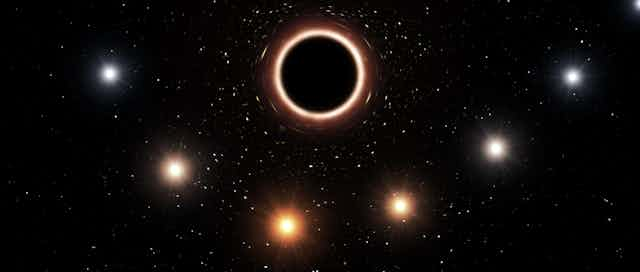For the past 30 years, scientists at the European Southern Observatory have been investigating the motion of stars near the massive black hole at the centre of our galaxy.
In July 2018, they revealed that they have directly observed the subtle “gravitational redshift” effect predicted by general relativity, the leading theory of gravity developed by Einstein.
This is the first time that astronomers have detected the effect in light from stars near the central black hole in the Milky Way.
The redshift effect
Redshift is a term that describes how light appears redder (that is, at a lower frequency) to an observer, compared to the point it was emitted. In general relativity, redshift arises for two main reasons. The first is the classic Doppler effect. This explains, for example, why an ambulance siren sounds a higher pitch (frequency) to someone when the ambulance is approaching them and a lower pitch when moving away. However, the siren always sounds the same to someone in the ambulance.
To understand this, consider different pulses of sound from the siren. If the ambulance is moving away from you, the time it takes a pulse to reach you is longer than the preceding pulse, because the ambulance has moved even further away in the time between the pulses. As a result, you hear the pulses less frequently than they’re emitted, making the siren sound at a lower pitch. In a similar way, the ambulance’s lights also appear (very slightly) redder to you than if the ambulance stopped.
The second cause of redshift is gravity – and this gravitational redshift is the effect detected in the latest results from the international team led by Reinhard Genzel of the Max Planck Institute for Extraterrestrial Physics in Germany. Such observations are difficult for many reasons, including the thick layer of dust between us and the galaxy’s centre. With new infrared technologies, scientists have managed to obtain sharp images of a dozen stars at the very centre, after corrections for blurring caused by the atmosphere. The star with the fastest orbital speed has shown the gravitational redshift effect predicted by Albert Einstein.
Gravitational redshift forms the very heart of how general relativity works. To understand it properly, one first has to understand the equivalence principle. This says that if you’re inside a closed spaceship without windows, you can’t tell whether you’re just sitting on the ground and feeling the Earth’s gravity or if you’re accelerating upwards in deep space, with no gravity. In both cases, if you drop a ball in the spaceship, it will accelerate downwards at 9.8 metres per second over each second that you watch it.
Remarkably, the equivalence principle allows you to convert gravitational problems (like how does light behave near a massive object) to a non-gravitational problem (how does light behave in an accelerating spaceship without gravity). In this case, we can use the principle to calculate gravitational redshift. Consider light moving away from the black hole, say from a distance of 100m to 101m miles. Intuitively, we expect the light to lose some energy climbing away from the black hole. But how much?

How starlight responds to a black hole
Instead of thinking about light moving upwards against gravity, we can think of it as moving upwards in a giant spaceship that accelerates upwards at the same rate as the gravitational pull at that point. Suppose the spaceship is not moving initially, when the light is emitted upwards from the bottom. By the time it reaches the top, the top wall of the spaceship is already moving away. As a result, the light is received at a lower frequency at the top wall than when it was emitted at the bottom wall.
Extending this logic to very large distance leads to Einstein’s predictions for how much light from an object will appear reddened just because it’s close to a massive black hole and we’re not. This gravitational redshift is normally rather subtle and can be easily obscured by a small error in calculations of the Doppler effect – for example, if the exact speed isn’t known. In fact, it’s normally rather difficult to know how much each effect actually contributes as we usually only know the total redshift.
Read more: Einstein’s theory of gravity tested by a star speeding past a supermassive black hole
The breakthrough made by Genzel and his team came from imaging the central region of our galaxy at high resolution over 26 years, using telescopes at the European Southern Observatory in Chile. Of particular interest was the star S2, which orbits the massive black hole at the galaxy’s centre every 16 years. Its highly elliptical orbit took it within 0.002 light years of the black hole in May 2018. Such a small separation enhances the orbital speed and thus the Doppler effect – but the gravitational redshift is enhanced even more, making it easier to detect.
The images were combined with spectroscopic measurements, where light is split into different wavelengths to identify particular features. Their frequencies are compared with laboratory measurements – the difference is called redshift. But is any of it gravitational?
The exquisitely sharp images tell us precisely how the star S2 moves, allowing scientists to calculate the conventional Doppler effect that this causes. The small remaining redshift (presumed gravitational) is only 10% off the amount predicted by Einstein, within the margin of error on these very tricky observations. I like to think he would have been very proud that his theory passed such a precise test in the extreme environment near a massive black hole.

